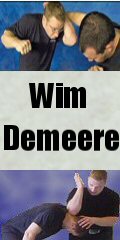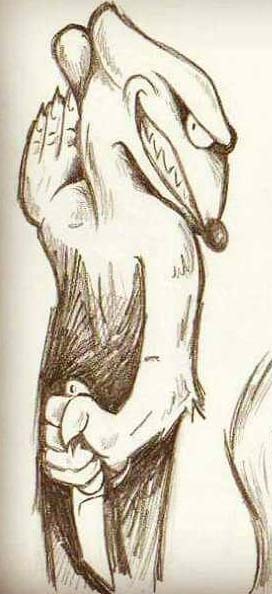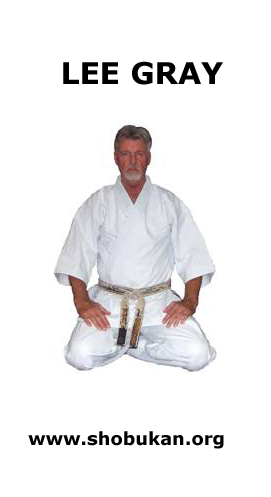|
|
||||||||
|
Search NNSD
In This Hub: Donate to NNSD
Marc MacYoung?
|
If you tell a lie big enough and keep repeating it, Ultimate fighting
systems, 'aliveness,' 'muscle memory,'
On this page: People often come to me and ask questions about violence and training based on a idea some marketing guru has promoted. Basically the question is framed in such a way that it is unanswerable- except within that model/marketing These ideas/training methods/ models are often outright advertising, but mostly they're half-baked, poorly understood information being presented as knowledge and understanding violence, self-defense and training. Often these are sincere questions, based on nonsense they've been told (e.g., "What's the fastest way to develop muscle memory?")
But the problem isn't just with the misinformation itself. These 'concepts' are especially appealing to people who are seeking a magic pill that will solve all their fears, automatically instill confidence, make them kick ass warriors over night -- and most of all --confirm what they already think they know about the subject. That's why these concepts are so popular and widespread over the internet. Even if you haven't drank the Kool-Aid, you can't get away from these concepts being passed off as legitimate. These soundbites, clich? and misunderstandings explain why most of the popular training systems are seriously -- if not fatally -- flawed for application in the streets. (And that's just from a stand point of their physical techniques. From legal, practical and how violence occurs they're really out to lunch when it comes to self-defense.) While the 'I got nothing" meme is funny. Here's an in depth answer to that question. The kid -- who was doing multiple techniques a week during his practice sessions -- asked me "how long must one practice a technique before you can make it work in a real fight." *sigh* ********** That is a simple question that doesn't have a simple answer. In fact by asking about muscle memory you're heading in the wrong direction to ever get an accurate answer. Let's start with this, there is no such thing as muscle memory. Muscles do not have brain cells -- ergo, no memory. What you do have is neural pathways. Pathways that repetition increases and enhance performance. The more you do a particular move -- for good or bad -- the more ingrained moving that way becomes. You may not realize it, but we've come to the first of many training landmines. It's easier to ingrain bad, ineffective and half-assed techniques than it is good ones. Practicing a move is GIGO: Garbage in, garbage out. OR, it can be ETIERO: Effective training in, effective results out. Neither what is 'garbage' or what is 'effective training' is determined by advertising, gym lore or a bunch of knuckleheads arguing 'Is too! Is not!' on internet forums. (Those are the same guys who also believe muscles have memory.) By the time you finish reading this, you'll have a better idea how to tell if the training you're getting is GIGO or ETIERO. What you also have is a brain that learns to process all kinds of complex information. This includes recognition, assessment, judgment and calculation. It does this at first consciously, then subconsciously and then nearly unconsciously. This is how you 'master' something. It's often referred to:
That last stage usually occurs while you're thinking about another part of the situationMost. But that only happens when something is so ingrained that you 'just do it' and don't even have to think about executing the mechanics correctly. The key word here is 'think.' The fact is conscious thought is really, really slow. Once you get skilled at something a lot of what is going on is happening in your faster subconscious. A BIG part of what people call 'muscle memory' is that you are unconsciously processing information to pick the right answer. It's not your muscles, the real work is happening between your ears. There's something else you should know about this mental processing. Depending on how intense the situation is, you could be doing it while talking to someone else or you're totally focused on another aspect of what you're doing. But before we go there, let's look at what's happening
inside
your body with those neural pathways You do this so you can move: What that means is when you tell yourself to act you do: 1+2+3. You do it in a blink of an eye and it has those three parts. When I said 'proper is important,' that's because you can also ingrain shit. you can just as easily ingrain bad habits. Habits that destroy the effectiveness of the move. So instead of doing 1+2+3 (which IS effective) you can ingrain 'muscle memory' that looks like 1+A+B+2.5+C+D. You've just created a real dog of a move. Now this bow-wow of a move might look like it works because it can be executed in training. But it has a high chance of failure when the guy you're facing isn't your friend. (As an interesting aside for both trainers and people trying to learn. All that extra crap is what people believe makes a move work. They put it in 'thinking' it will make the move more powerful and effective. Unfortunately it doesn't add power, it robs them of it.) (2) This is the fundamental flaw of most 'aliveness' training. They are jumping in dealing with active resistance before they've ingrained the neural pathways. So instead of starting with 1+2+3 and then teaching you how to apply them against an active opponent (which is actually the next step) they START your training with 1+A+B+2.5+C+D. That's what you're going to ingrain. These are bad habits that rob you of power. The reason that people believe they work is that a lot of the extra stuff they put in is strength and blind aggression.(3) Which works fine as long as you carefully select to only fight people smaller, weaker and less aggressive than you. If you only pick fights with 4th graders, you'll win every fight. Unfortunately, if you meet someone bigger, stronger, more aggressive and try to fight like that, he's going to hand you your head. Oh yeah, and it also fails miserably against people for whom violence isn't a macho monkey dance. But they'll just shoot you in the face. Having effective mechanics that you can perform without thinking about IS critical for not getting your head beaten in. But, there's a LOT more to a punch than just sticking your fist out in the air really fast. An effective move -- any move -- is a complex process of movement, tensing and relaxing muscles, body posture and sequential timing. These are what you need to have ingrained so well in your training that you don't even have to think about moving in this manner. When you get the trigger, you just unconsciously do it. This is unconscious competence. Your brain doesn't have to waste resources to make sure you're doing the move 'right' (which is what happens with conscious competence and conscious incompetence) More than that, you know the strengths, limits and application of a move so well that the circumstances are the trigger for it. For example you 'know' the range of a punch so well when you see the guy moving towards that location you automatically fire the punch. Both arrive at that location at the same time. This is what most people believe they are talking about when they use the term 'muscle memory.' But most people use that term like some kind of magic fairy dust that makes everything work. Being able to physically execute the move effectively is less than half of the equation. A BIG part of unconscious competence is happening in between your ears, NOT how you are performing the mechanics of a move. It's being able to subconsciously recognize when and under what circumstances to execute a move. Is the guy in the right range to do that move? Are you in the right position to execute that move? Is he in the right pose? Are you in the pose? It's being able to -- at a glance -- know, 'now is the time for that move.' Once you see the conditions, BAM! The move happens. It's also knowing 'if I move here, then BAM!" that's the move to use. And all of this happens in a glance. It happens faster than conscious thought. You see it, you know it and you do it. This isn't magic. It's that you know your tools so well that you don't have to consciously think about when is the right time to use them. (You grok the technique). You subconsciously assess that the conditions are right (opportunity) for this move. Once that is assessed, the technique is automatically executed correctly.
As a formula it would read:
If it's close, but not quite right, then it's I'm talking about knowing a move so well that it's a matter of inches. You see a guy moving into range -- for say a punch -- and faster than you can consciously think, you fire that punch. Not at him, but where he's going to be. He moves right into it. OR you're there and you -- again faster than conscious thought -- slip right into where you need to be for the mechanics of the punch to be the absolute best it can be.
I'm going to take this out of fighting and point towards
something that people do this kind of 'thinking' all the time.
Well, if they don't they get in a lot of accidents. That is
driving. Basically driving only consists of three things
It's how you mix and match those elements for the circumstances
that determine if you arrive safely or get into an accident. To
further break it down we can add that driving is a combination
of Going back to steering, braking and accelerating. Each of these elements is a skillset in and of itself. For example: Braking is applying pressure to the brake to stop the car. But how much pressure,timing, adjustments? ALL play an important part in developing this skillset of braking. As does calculating speed and distance. That translates into assessing how much pressure, timing and adjustments you'll need to apply to the brakes when you're traveling (this) fast and in (that) distance. When and how hard you brake is different when you're traveling at 70 miles an hour than at 35 to stop at a certain point. AND you have to learn how to adjust pressure as the car slows down. This is called 'threshold braking.' You start applying this much pressure at 70 mph and then you adjust it when you're at 35 mph because if you don't your head is going into the steering wheel. Braking is just one skillset of driving. Skillsets is the closest you will come to 'muscle memory' in learning how to drive. Even then though, you'll see how much subconscious processing (thinking, calculating, assessing, judging) is going on. But you do need to develop the neural pathways to smoothly and effectively execute the physical move. The 'Skill' of driving is combing those skillsets. It's also having learned how to assess and calculate conditions so you can make the right combination for ever changing circumstances. Simple version: Light turns red, which skillset do you use? More complex: You're coming up to a curve that's marked 50mph. You're doing 60mph, what do you do to get through the curve? Where do you put your car before you enter the curve. What combination of the three do you do to get through it? Advanced: You're driving a race car going 120 mph and approaching a curve. Each of these scenarios use the same three skillsets. The combination that is correct is different for each. Skill is knowing when to use a single one, when to combine them, the proportion of each and the timing you'll need. It's also doing this every few seconds to adapt to changing circumstances. You've made it through the turn, now what do you do? It depends on the circumstances. The 'Art' of driving is almost being psychic. It's knowing the flow and patterns of traffic and road construction that you can look at a situation and predict what is going to happen ... and then you adjust steering, braking and accelerating accordingly. Someone who has developed the art of driving will move to avoid a situation that will be happening 10 seconds from now. The simplest version of this is seeing someone about to get onto the freeway, you change lanes so you don't have to slow down. Everyone will drive on smoothly and you won't spill your coffee. Other drivers, however, will see the car getting on and not do anything until they have to slam on the brakes to avoid an accident. Coffee goes flying. The same concepts I just described apply to fighting moves. Experienced fighters have ingrained the skillsets of a technique. When they do it, they do it well internally. A big part of why they do it well externally is they have developed the skill to know when to do it and what kind of adjustments they have to make for changing circumstances. This is skill. Someone who has moved into unconscious competence has gotten into the 'art' stage. In fact, they make it look easy. The reason it works so easily for them is that they've spent all this time learning to move, assess, process, adjust and effectively execute the 'right' move. Your question is how long do you have to practice before a technique becomes effective? I told you that was an inaccurate question. The reason why I said that is you can take everything I've said an apply them to EVERY technique you know. Boxing only has four (arguably five) fundamental punches. Yet every boxer knows those punches as well as I have described to you here. In the simplest forms, martial arts adds in kicking and grappling. There's a LOT more different kinds of offensive and defensive movements still out there. How deep do you want to go? The good news is most champion fighters only use three or four techniques that they've perfected. They've taken these moves into the art stage. That means they'll see an opportunity and faster than a rattlesnake on speed and with more effective momentum than a freight train BAM! But that takes practicing these moves to incredible depths.
Training Tips IF you spend days doing just one technique make sure you're training to do it right. It's focusing on the 1+2+3 instead of just sticking your fist out there and calling it a technique. The more you focus on quality, the more you will get out of quantity.
What's the
range of a move? Every move has an optimum range where it
has the most power. Too far or too close and you lose power. Do
you know the range of your moves? What is the 'timing' of a move? By that I mean what muscles do you tighten and then release as you move through the move? These are the body mechanics of a move (and actually the bunkai) when you are in this part of the technique these muscles are tight, but when you get to this part, you release those and tighten these others. What needs to move first in order for everything to get there at the same time? If you don't focus on this all you're doing is sticking your hand out there. What are the poses/positions you are in AS you execute the move? The human body is flexible. This flexibility can work for you or against you. How you hold your body (pose) is going to determine if you're going to hit him with an iron bar or a pillow. It doesn't matter how much force you generate, if you position your body wrong it's like hitting him with a pillow. Your body and joints will 'flex' and create shock absorbers. A properly executed technique (1+2+3) minimizes this kind of energy loss. The reason you have to hold your elbow this way and move your shoulder that way is to take out the 'pillow effect' that occurs when you are trying to punch with your body parts in a different pose. Again, I want to stress you do this with EVERY technique you know. Both offensive AND defensive. Quality is WAY more important than quantity. And this especially means being a 'technique collector' and having 5000 techniques that you only partially know. I know that this goes against the whole idea of cross training and mixed martial arts, but having three or four moves that reliably work to end a fight is WAY better than having a boatload of moves that you can only half-assed do. Not only because you can 'git r done' using those moves, but because when it's over with quick, you don't need all those other things you can't do very well. Does that mean you shouldn't cross train and get other techniques? No. What it means is focus on one move until you understand it and can make it work under all kinds of circumstances (like being able to throw an effective cross when you're scared and against a moving target) THEN start the whole process over again on another technique. That way, even though it takes time, at each step of the way you have something that works. If you spend a week of quality time on one punch, you'll get pretty good at it. Then move onto another punch for another week. At the end of three weeks, you got three quality punches. But if you spend three weeks doing 50 different technique, you got 50 things you don't any of them well. You have 50 things you don't understand when and where to apply them or what you have to do to adjust so you can apply them.
"Contrariwise," continued
Tweedledee... Yes I just quoted "Alice in Wonderland." That bit on nonsense is actually a pretty good summation of the kind of thinking that comes from mistaking advertising for knowledge. Here's a point to consider, when it comes to commercialized training those big 'selling points,' their superior technique, their scientific training methodology, their emphasis on how violence really happens, their ultimate fighting style... all have a degree of truth. Here's the hitch, it's not the whole of the subject. The elements they are pitching to make themselves stand out from the competition are indeed important elements. But they are neither the most important or any secret revealed knowledge. I liken these elements to a slice of the pie. Another way to look at it is they are all parts of the whole. A whole that needs all of those parts to work effectively. If you don't have them, then the chances of you failing are high. Do you need to have mastery of all of them? No. That's both impossible and outrageously expensive. But you do need to have a basic introduction to what these programs are selling as why they are superior. Some examples -- functioning under adrenal stress, going against a resisting opponent, mistake recovery and lethal force. All of these I've seen pitched as programs 'secret sauce.' Have you ever noticed your lost keys are always in the last place you look? That's because once you find them you stop looking. The problem with buying into a program's advertising the ultimate fix is you stop looking into those other elements. The biggest danger to you when it comes to using your training is if you've bought into what I call "One stop shopping." That's when you believe the sales pitch (or worse, the training matches your imaginary version of what crime and violence are). So instead of expanding your knowledge and understanding into those other elements, you think you have them covered with the specialized training you're getting.
Years ago I saw a cartoon gag where a huckster says. "Can I
interest you in a bulletproof vest? Only used once." The vest he is
holding up has a massive through and through hole. Unfortunately a
lot of the training that is being sold is like that vest. You
won't know what's missing until it fails in application. In Conclusion When it comes to fighting a lot of people are looking for a magic pill that if they take it, they'll get results overnight. Not only is there no such thing, but there's no simple training solution. There are no short cuts, but that doesn't mean there aren't people out there selling them. Or buying them Most of what people think they know is advertising. There's no -- if you do mixed martial arts, do reality based self-defense, know some ultimate fighting system or know some ultimate fighting technique that starts with "The ...." -- you'll be able to kick ass and take names just by knowing it. What there is is a lot of focusing on ingraining not only 1+2+3, but developing skill sets, skills and art in being able to effectively move, defend and deliver force in a violent encounter. It boils down to investing the time, focus, skullsweat and practice of effective movement so you can git r done when it's hitting the fan. Otherwise, it's someone taking your money to give you a magic pill. Which works fine in the gym, but can get you killed in the streets. Return to top
1)
The rest of the quote: If you tell a lie big enough and keep
repeating it, people will eventually come to believe it. The lie
can be maintained only for such time as the State can shield the
people from the political, economic and/or military consequences
of the lie. It thus becomes vitally important for the State to
use all of its powers to repress dissent, for the truth is the
mortal enemy of the lie, and thus by extension, the truth is the
greatest enemy of the State. 2) A useful trick for spotting when you're adding these extraneous moves in is to video your training sessions -- especially if you train alone. When you are executing a move you won't be able to see small things like unconsciously raising your elbow during a punch. By video taping and watching yourself you can spot these extra and unnecessary movements you're unconsciously putting into your movement. Return to Text
3) Matt Thorton made a huge production
about the importance of 'aliveness' in training. He also gave
Kool-Aid drinkers a great way to pat themselves on the back for
being smarter than traditional martial arts practiticioners.
This self-induced superiority is because they don't
practice dead or static drills the martial arts teaches.
According to this mythology, these dead drill don't prepare you
for 'real' fights (as if sports based grappling does). While
there's some validity to this claim when it comes to
commercialized and watered down 'traditional' martial arts, it's
replacing one bad training model with another. Mostly by jumping
ahead and introducing resistence and complications before
a person has sufficiently ingrained 1+2+3 body mechanics of a
move. |

|
||||||
|
Last | |||||||











